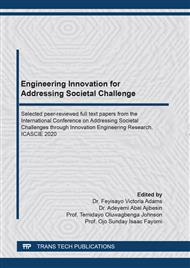[1]
K.,. D. Acharya, Comparative Analysis of Different Modulation Techniques of LTE Network,, Third intenational conference on computer, communication, control & information technology, p.6, (2015).
DOI: 10.1109/c3it.2015.7060144
Google Scholar
[2]
K. Pandya, comparative study on wireless Technology: 1G, 2G, 3G, 4G & 5G,, International Journal of Recent Tends in Engineering & Research, vol. 1, no. 1, p.5, (2015).
Google Scholar
[3]
S. &. K. Patel, comparative study of 2G, 3G & 4G,, International Journal of Scientific Research in Computer Science, Engineering and Information Technology, vol. 3, no. 3, p.3, (2018).
Google Scholar
[4]
R. Arshad, Performance Assessment of Orthogonal Frequeny Division Multiplexing (OFDM) in Wireless Communication System,, International Journal of Applied Engineering Research, vol. 11, p.9, (2016).
Google Scholar
[5]
Q.-A. Dharma, Introduction to Wireless and Mobile Systems, United State: CENGAGE, (2011).
Google Scholar
[6]
H. A. Carnes, The use of data envelopment analysis for evaluating building energy consumption in terms of productivity,, US department of energy, office of science & technical information, p.12, (1998).
Google Scholar
[7]
D. &. Tugcu, energy efficiency in energy production:data envelopment analysis (DEA) approach for the G-20 countries.,, international journal of energy economics and policy, vol. 5, no. 1, p.7, (2015).
Google Scholar
[8]
O. &. k. Kogias, comparative performance evaluation of m-ary QAM modulation shemes using simulink and BERTool,, ARPN Journal of Engineering and Applied science, vol. 12, p.7, (2017).
Google Scholar
[9]
A. Oyetunji, performance evaluation of digital modulation techniques in AWGN communication channel,, International Journal of Engineering Research & Technology , vol. 2, no. 5, p.7, (2013).
Google Scholar
[10]
D. &. Nishat, performance evaluation of digital modulation schemes BPSK, QPSK & QAM,, international journal of engineering and techniques, vol. 3, no. 2, p.4, (2017).
Google Scholar
[11]
B. &. Rao, evaluation of BER for AWGN , Rayleigh and Rician fading channels under various modulation schemes,, international journal of computer appliance, vol. 26, no. 9, p.6, (2011).
DOI: 10.5120/3132-4317
Google Scholar
[12]
P. &. Chitra, performance evaluation of energy efficient modulation scheme and hop distance estimation for WSN,, international journal of communication network and security, vol. 2, no. 1, p.6, (2010).
Google Scholar
[13]
Mahalakshmi, performance evaluation of various digital modulation schemes for an efficient wireless mobile communication system,, international research journal of engineering and technology, vol. 5, no. 9, p.4, (2018).
Google Scholar
[14]
M. Zodpe, performance analysis of different modulation shemes using Wi-MAX and LTE,, international research journal of engineering and technology, vol. 4, no. 7, p.9, (2017).
Google Scholar
[15]
Y. &. Abdelfattah, performance evaluation of different QAM techniques using Matlab/simulink,, long island systems, applications and tchnology, p.5, (2013).
DOI: 10.1109/lisat.2013.6578237
Google Scholar
[16]
O. &. I. Ndujiuba, comparative analysis of digital modulation techniques in LTE 4G systems,, Journal of wireless networking and communications, p.7, (2015).
Google Scholar
[17]
V.M.C. Ajibesin, Data envelopment analysis with slacks model for energy efficient multicast over coded packet wireless networks,, The Institution of Engineering and Technology Science, Measurement and Technology, p.12, (2014).
DOI: 10.1049/iet-smt.2013.0195
Google Scholar
[18]
Mathworks: MATLAB and Simulink user community https://www.mathworks.com/.
Google Scholar
[19]
GausGaussianWaves: Signal Processing Simplified https://www.gaussianwaves.com/.
Google Scholar


